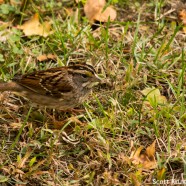Late Eastern Kingbirds
These Eastern Kingbirds (Tyrannus tyrannus) are running a bit behind schedule, and September 30 is now the latest sighting of the species I have had in Connecticut. These photos are of two continuing birds at Stratford Point, the first two shots of the same individual taken against the blue sky on September 28, and the other two being one of each while viewed simultaneously after a cold frontal passage today on September 30. My previous late date was September 19, 2011 at the Boothe Park Hawk Watch. Fortunately for these birds it has been an extremely and historically warm September, but...
Read MoreChestnut-sided Warbler Singing
Frost in the morning – sunny cheer by lunchtime. It’s spring in Chautauqua County! This Chestnut-sided Warbler seemed excited about it all…
Read MoreWhite-throated Sparrows massing and feeding
White-throated Sparrows have arrived in tremendous numbers across the region, ready to eat you out of house and home all winter long! Before then, while the grass and earth is still exposed, without being snow-covered or frozen, they can feast on more natural meals. I took a bunch of photos of a few individuals in a group feeding on the lawn last week. There would not be much to chow down on if this were uniformly treated bright, green grass, one species that was chemically induced to look like the perfect lawn. These monocultures are taking up valuable habitat real estate and often consist...
Read MoreMorning-glory Plume Moth (Emmelina monodactyla)
This looks to be a Morning-glory Plume Moth (Emmelina monodactyla), one that I photographed only last week. Even as we enter November and have already experienced frosts, freezes and early season snowfall in the Northeast (and the Southeast?!) there are still a wide variety of flying insects to be found. Many of our tiny neighbors can be discovered year-round. It only takes a little more effort on our part to spot them. Put on an extra layer if you need it but get outside as much as you can. Scott Kruitbosch Conservation & Outreach Coordinator
Read MoreResting Monarch
This Monarch butterfly was content to take a rest out of the wind for a while. Part of what must make a Monarch’s migration so difficult is that autumn days with warm temperatures are often those that feature a strong southerly flow – precisely the opposite of the direction they’d like. Finding sunny and warm days with a tailwind out of the north is not easy in September or October, especially in the Chautauqua-Allegheny region with lake effect clouds and precipitation even under high pressure. This is before we mention the cool temperatures associated with those...
Read More








